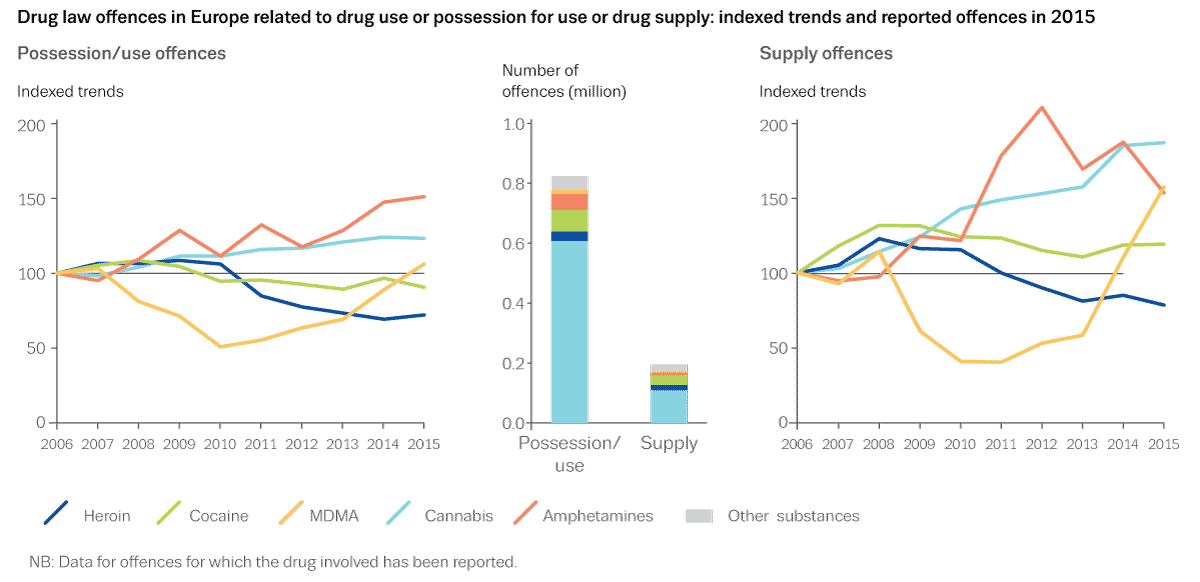Statistical Bulletin 2017 — drug law offences
Archived content
Reports of offences against national drug legislation (use, possession, trafficking, etc.) reflect differences in law but also the different ways in which the law is enforced and applied, and the priorities and resources allocated to specific problems by criminal justice agencies. In addition, information systems on drug law offences/offenders vary considerably between countries, especially as regards recording procedures, definitions and statistical units (see below).
Data tables
Use the menu below to find data sets of interest.
Graphics
Click on a graphic from the thumbnails below
Methods and definitions used
Reports of offences against national drug legislation (use, possession, trafficking, etc.) reflect differences in law but also the different ways in which the law is enforced and applied, and the priorities and resources allocated to specific problems by criminal justice agencies. In addition, information systems on drug law offences/offenders vary considerably between countries, especially as regards recording procedures, definitions and statistical units (see below).
The term ‘reports for drug law offences’ covers different concepts, varying between countries. Drug law offences usually refer to offences such as drug production, trafficking and dealing as well as drug use and possession for use. Although in some countries, drug use and/or possession for use are not considered as criminal offences and attract administrative sanctions, reports for these were included in the data presented here.
The stage within the criminal justice system at which data have been reported and recorded, vary sometimes across countries. For example, data on drug law offences might be recorded at an initial stage when a first report is made by law enforcement agencies, or after investigation by the Judicial Police, or even following a decision for a charge to be issued by the Prosecutor.
Statistical units vary between countries. Some countries record offences while others record persons (or presumed offenders). Among those recording offences, some record all offences reported to them, while others record only the main offences — i.e in the case of several offences committed by the same person, only the most serious offence (usually the one that attracts the highest penalty) is recorded. Among countries recording persons, some record a number of individuals being reported during the year, while others report only a number of different individuals reported during the year. In the former case, an individual reported twice during the same year will be counted twice while in the latter case he would be only counted once in the statistics. In addition to these, when considering breakdowns by drug, here too, some countries report all drugs mentioned in a case while others record only the main drug (defined according to different criteria in different European countries).
These differences — mainly in the stage at which the statistics are made and in the type of statistical units — lead to major difficulties when comparing data from different European countries.
For additional information, see the EMCDDA’s European Legal Database on Drugs (ELDD) and the Information map on law enforcement sources.
Definitions — Terminology used in defining drug law offences in Europe
| Country | Definition |
|---|---|
| Belgium | Police reports of offences related to illicit drugs. |
| Bulgaria | Police reports of detainees for drug law offences. |
| Czech Republic | Reports of drug law offences. |
| Denmark | Charges for violations of drug laws. |
| Germany | All offences under narcotic law. |
| Estonia | Persons reported for offences against the drug legislation (criminal offences and misdemeanours). |
| Ireland | Drug offences where criminal proceedings commenced (charges) and where the offence is classifiable by type of drug. |
| Greece | Arrests (caught by the police); initial reports of individuals suspected of drug law offences. |
| Spain | Arrests made in case of dealing/trafficking (criminal offences) and reports made in case of possession/use in public places (administrative offences). |
| France | Reports by law enforcement agencies for violation of drug laws to the prosecutor. |
| Italy | Reports of drug law offences: persons referred to the Judicial Authority (criminal offences) and persons referred to the Prefect of the police force (administrative offences). |
| Cyprus | Reported cases of drug law offences. |
| Latvia | Criminal convictions for drug law offences. |
| Lithuania | Arrests and charges for drug law offences. |
| Luxembourg | Suspected offenders (‘prévenus’) against the 1973 drug law. |
| Hungary | Charges for indictable drug law offences (i.e. cases of drug abuse reported by police and prosecutors at the end of criminal investigations). |
| Malta | Persons charged with drug law offences. |
| Netherlands | Offences against the Opium Act considered in need of Prosecution Department. |
| Austria | Reports to the police for violations of the Narcotic Substances Act. |
| Poland | Offences against the drug law recorded by the police. |
| Portugal | Presumed offenders questioned by the police for drug-related offences (criminal offences) and suspected drug users referred to the Commission for the Dissuasion of Drug Use (CDT) (administrative offences). |
| Romania | Persons investigated by the police for drug law offences. |
| Slovenia | Presumed offences against drug legislations. |
| Slovakia | Suspected offenders convicted of drug law offences, reported by KEU PZ. |
| Finland | Suspected drug offences recorded by the police and the customs (from 2002 only). |
| Sweden | Persons suspected of offences against the narcotic drugs act or the goods smuggling act. |
| United Kingdom | Persons found guilty, cautioned, given a fiscal fine or dealt with by compounding for drug law offences. |
| Croatia | Persons arrested for drug law offences. |
| Turkey | Offences brought up by the main law enforcement authorities (police, Gendarmerie, customs) for drug law offences. |
| Norway | Cases investigated and persons charged with drug crimes. |
Source: Reitox national focal points.









